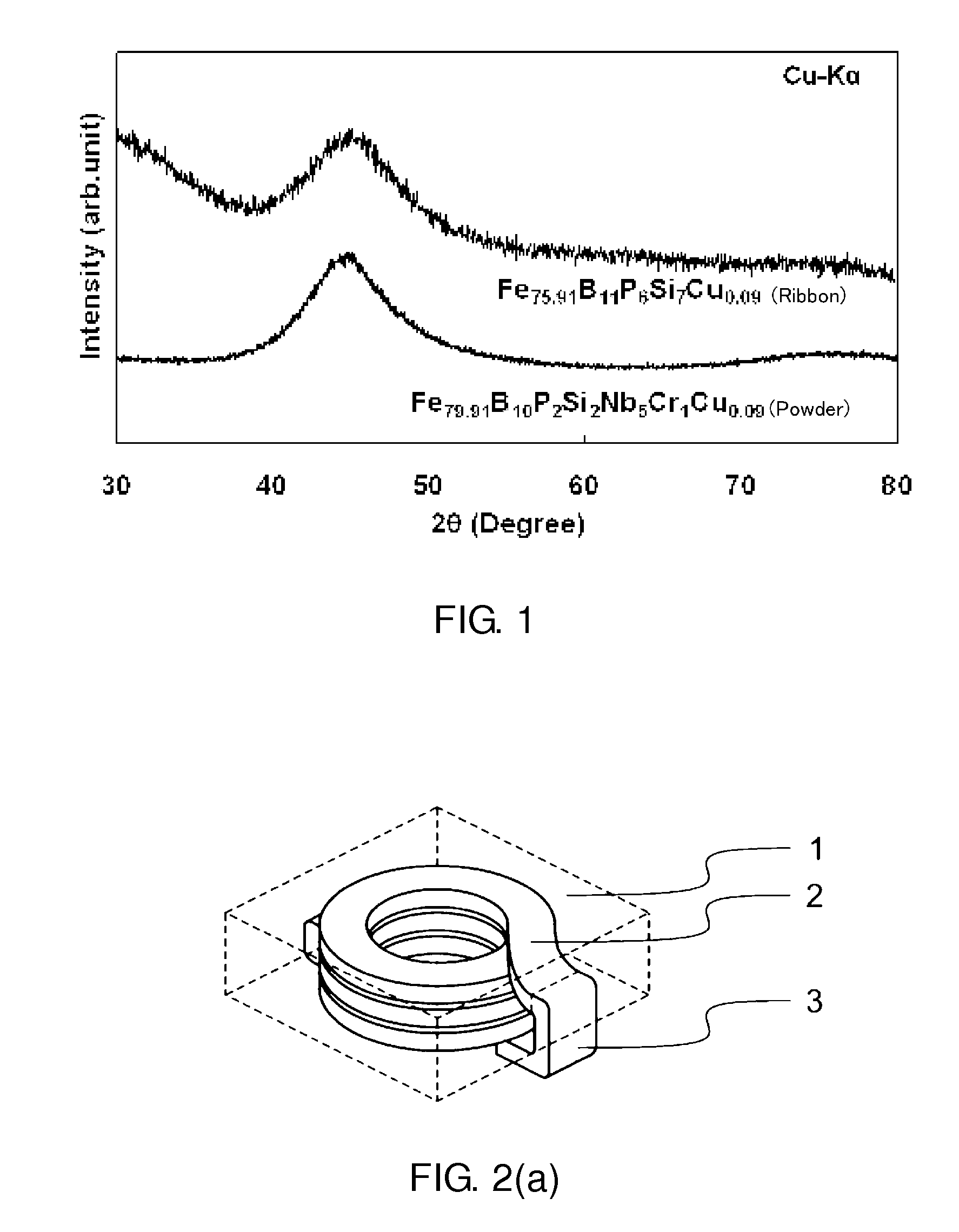Soft magnetic alloy, magnetic component using the same, and thier production methods
a soft magnetic alloy and magnetic component technology, applied in the direction of magnetic bodies, transformers/inductances, magnetic cores, etc., can solve the problems of low amorphous phase forming ability limited use of fe-based amorphous materials, unsuitable commercial materials, etc., to achieve excellent soft magnetic properties and high forming capability
- Summary
- Abstract
- Description
- Claims
- Application Information
AI Technical Summary
Benefits of technology
Problems solved by technology
Method used
Image
Examples
examples 259-266
[0104]Materials of Fe, B, Fe75P25, Si, Fe80C20, Cu, Nb, and Cr were respectively weighed so as to provide alloy compositions of Examples 259-266 of the present invention as listed in Table 11 below and put into an alumina crucible. The crucible was placed within a vacuum chamber of a high-frequency induction heating apparatus, which was evacuated. Then the materials were melted within a reduced-pressure Ar atmosphere by high-frequency induction heating to produce master alloys. The master alloys were processed by a single-roll liquid quenching method so as to produce continuous ribbons having a thickness of 25 μM, a width of about 5 mm, and a length of about 10 m. For each ribbon, the resistivity was evaluated with a resistance meter. Furthermore, the ribbons were used to produce a wound magnetic core having an inside diameter of 15 mm, an outside diameter of 25 mm, and a height of 5 mm. The initial magnetic permeability was evaluated at 10 kHz and 100 kHz, respectively, with an imp...
example 288
[0114]Next, there will be described the evaluation results of an inductor produced by providing a coil on a dust core formed of soft magnetic powder according to the present invention. The produced inductor was an integrated inductor in which a coil is provided inside of a dust core. FIGS. 2(a) and 2(b) are views showing the inductor of this example. FIG. 2(a) is a perspective view in which the coil can be seen through the inductor, and FIG. 2(b) is a side view in which the coil can similarly be seen through the inductor. In FIGS. 2(a) and 2(b), the reference numeral 1 denotes the dust core, the outline of which is shown by the dashed lines, the reference numeral 2 denotes the coil, and the reference numeral 3 denotes a terminal for surface mounting. First, a sample weighed so as to have the composition of Fe79.9Si2B10P2Nb5Cr1Cu0.09 shown in Example 2 was prepared as a material according to the present invention. This sample was then placed in an alumina crucible, subjected to evacu...
PUM
| Property | Measurement | Unit |
|---|---|---|
| average grain diameter | aaaaa | aaaaa |
| thickness | aaaaa | aaaaa |
| diameter | aaaaa | aaaaa |
Abstract
Description
Claims
Application Information
 Login to View More
Login to View More - R&D
- Intellectual Property
- Life Sciences
- Materials
- Tech Scout
- Unparalleled Data Quality
- Higher Quality Content
- 60% Fewer Hallucinations
Browse by: Latest US Patents, China's latest patents, Technical Efficacy Thesaurus, Application Domain, Technology Topic, Popular Technical Reports.
© 2025 PatSnap. All rights reserved.Legal|Privacy policy|Modern Slavery Act Transparency Statement|Sitemap|About US| Contact US: help@patsnap.com



